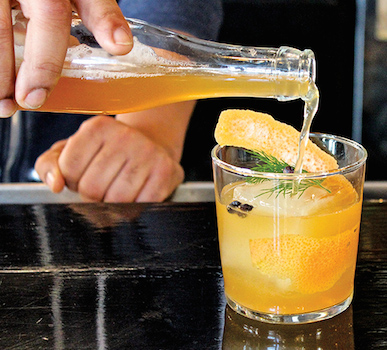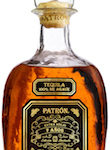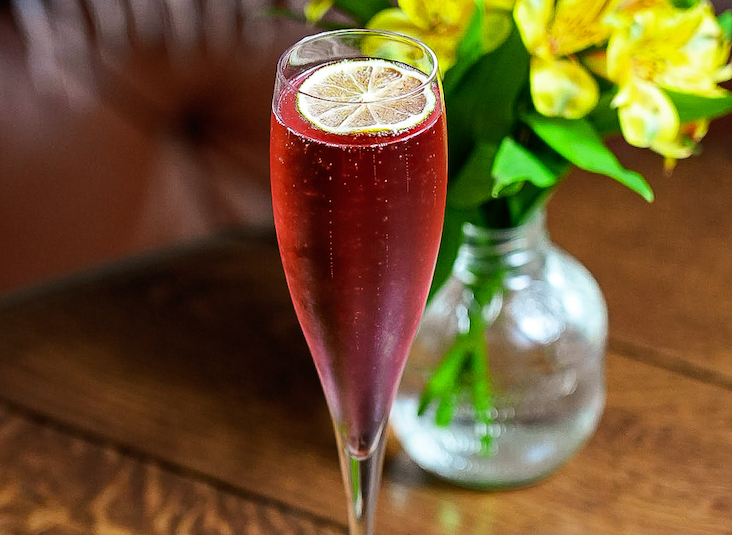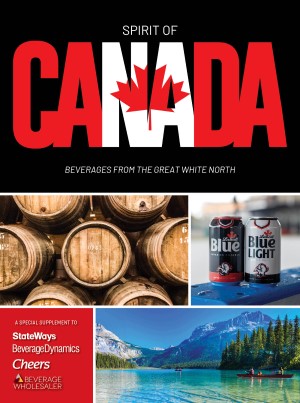Ah, the garnish.

Chicago restaurant Travelle offers a vodka Martini garnished with olives stuffed with caviar and a spritz of truffle mist.
Part decoration, part cocktail ingredient, it’s often the first thing a customer notices when a drink is set in front of him or her.
In the case of over-the-top, whimsical or artistically inspired adornments, garnishes can tempt with striking visual appeal. A smacked sprig of a fresh herb, or the oil from a swath of orange or lemon peel can offer up intoxicating aromas as the glass is lifted.
And of course, a zesty squeeze of lime or a salt-crusted glass adds to a cocktail’s flavor with each sip. Unlike the dark days of cocktails, when puny, half-dried-out lemon slices or bright red, artificially flavored cherries ruled the condiment tray, today’s garnishes are an integral part of a great drink.
“The right garnish completes a cocktail and enhances the more subtle flavors,” says Taha Ismail, the beverage director for the five restaurants of the Washington, D.C.-based Mike Isabella Concepts. He’s seen an uptick in savory garnishes, including herbs, oils and vegetables such as radishes and green peas.
Ismail’s Smile Like a Donut cocktail ($13) at Greek restaurant Kapnos mixes Beefeater 24 gin with Idoniko brandy and house-made grapefruit tonic, garnished with dill, juniper berries and dehydrated grapefruit. The Hannibal ($12), served at the company’s new Greek restaurant Kapnos Taverna, shakes up mezcal, Curaçao, lime juice and ginger, finished with a chili oil float.
How does Ismail select garnishes? “Stick to the flavor profile of the drink and maintain a balance, making sure the garnish doesn’t upstage the cocktail,” he advises.

Jockey Hollow Bar and Kitchen in Morristown, NJ, serves its Pizza Connection amaro cocktail with a dehydrated lemon chip floated on top to resemble a pizza.
To assure that the drink—rather than the garnish—is front and center, design a tipple’s adornment according to how many ingredients it has.
“If your drink [has] a simple one or two ingredients, it’s because you are supposed to be enjoying those two ingredients,” says Richard Ellman, owner and mixologist of the 137-seat global cuisine restaurant Oak in Dallas.
Thinking beyond the citrus
Citrus has always been a favorite tipple topper among bartenders, as it can add a refreshing, mouthwatering squirt of acidity—or more depth of flavor from the peel’s essential oils. But some bartenders now eschew the traditional forms in favor of more creative flourishes.
“Instead of your simple lime wedge on a Margarita, try a kaffir lime leaf,” says Ellman. “It will have the added zest necessary to the nose of the drink, without overdoing the citrus on the palate.”
He also recommends creative touches, such as torching a lemon to add a touch of smoke to a sip, and creating candied lime wedges to better balance citrus and sweet.
Jockey Hollow Bar and Kitchen in Morristown, NJ, uses dehydrated fruit for striking drink toppers. For instance, the Pizza Connection ($15) has Nardini Ruta Aqua Vitae, Cocchi di Torino, Solerno and Nardini Amaro Bassano, with a dehydrated lemon chip floated on top to resemble a pizza.
Head bartender Christopher James believes the “oversized swath of citrus” as a garnish is overdone: “It should only be used for certain drinks, not for everything with a citrus peel.”
Colin Anderson, bar manager at the 44-seat contemporary Mediterranean restaurant Cure in Pittsburgh, PA, agrees. “I think we were all getting sick of garnishing drinks one or two ways: either with a citrus peel or with a cherry.”
If bartenders do use citrus peels, Anderson says, they should trim the edges for a sleeker appearance. “It makes the drinker realize, in the slightest of ways, that the bartender cares about the look of the drink.”
Fresh herbs can add another dimension to cocktails: Anderson notes that herbs work wonderfully with fresh citrus, including orange peel and rosemary for rye whiskey sips, and lemon and thyme for gin. James is partial to fresh thyme, and also likes using rosemary that’s slightly dried.
It’s complicated
“Over-the-top, yet whimsical garnishes are really popular right now,” says James. Jockey Hollow’s Martini ($15) uses baby clothespins to hold a long lemon twist to the side of the glass.

The Martini at Jockey Hollow Bar and Kitchen is garnished with a long curl of lemon peel clipped to the side of the glass with a tiny clothespin.
The concept’s Teach Me How to Dougie cocktail ($15) mixes Purity vodka, Clear Creek Douglas Fir eau de vie and lime; a mizuna leaf floated on top resembles the Douglas fir tree on the pine liqueur’s label. “If [garnishes] have a certain level of whimsy, it kind of balances out the over-the-top factor.”
Matt Tocco, beverage director of the 200-seat Pinewood Social in Nashville, TN, has also seen a trend in over-the-top garnishes. He attributes this in part to the rise in popularity of Tiki bars and drinks.
Pinewood Social’s cocktail A Stranger in the Alps ($12) is made with Junipero gin, Carpano Antica sweet vermouth, Luxardo Bitter and Braulio Amaro. It’s served with a long “pigtail” lemon peel twist wrapped around a chunk of ice, and drizzled with Clear Creek Douglas Fir eau de vie.
“It looks a lot like a crown of thorns,” Tocco says of the garnish. Any garnish “should be echoing, complimenting or mirroring other flavors in the drink,” he says. “It also shouldn’t take forever to make.”
Cure has topped sips with components including candied fruit, caramel candies, Pop Rocks and agar gelatin pebbles, Anderson says. The restaurant’s cocktail Gin ($10) uses Old Tom gin, riesling-based vermouth, preserved peach liqueur and catnip tincture. It’s finished with a lemon wheel placed on the rim of the glass, along with a syrup of lemon oil, mint leaf and fragrant red agar pebbles.
But what about the fear of a garnish looking too precious or ostentatious? “If it complements and enhances the drink and one’s senses, it will not come across as pretentious,” says Anderson.
Ellman notes that as long as a garnish is practical—and actually adds something to the cocktail—it can be as over-the-top as you want. The State Fair Cocktail ($12) served at Oak mingles Pama pomegranate liqueur with fresh lemon, topped with prosecco and lime cotton candy.
Foaming in the glass
One drink embellishment that comes under fire for being too fussy is foam. “I’m not a fan of foams and airs that are just floated on top,” admits Ismail. “They can look good, but they rarely add anything real to the drink.”
A staple in molecular gastronomy—and mixology—foams are meant to add texture, aroma and a hint of flavor. When done right, they can be striking additions to cocktails.

A Stranger in the Alps, a cocktail at Pinewood Social in Nashville, TN, is garnished with a long “pigtail” lemon peel twist wrapped around a chunk of ice, and drizzled with Clear Creek Douglas Fir eau de vie.
Chef José Andrés’ concepts have long used airs in dishes and sips; at The Bazaar by José Andrés, a 417-seat modern Spanish molecular gastronomy restaurant in Los Angeles, the Truffle Noir ($17) mixes mezcal, Drambuie, blueberries and lime, garnished with truffle salt air. The “New Way” Dirty Martini ($17) tops the classic drink with a spherified olive and olive brine air.
Less is more when it comes to most foams, says The Bazaar bar manager Vahan Petrossian. “Garnish conservatively to enjoy the essence of the air.”
Modern foams typically use soy lecithin and need to be made à la minute, which can be tricky for busy bars. “An iSi whipper works great with some egg whites, a sugar (liqueur), acid (citrus) and a double charge,” explains James.
A challenge with foam finishes is when—and how—to actually sip the drink through the whipped layer on top. Cure has solved that dilemma by “gluing” a dehydrated piece of citrus to the rim of a glass with a highly concentrated complementing flavored syrup, and then dropping the foam on top.
Cure’s Rum ($10) mixes rum with Lillet Blanc that’s infused with oranges and cinchona bark, preserved-rhubarb liqueur, and sumac bitters; a dehydrated orange wheel set on the rim of the glass is topped with a rich Campari syrup and a mountain of sumac foam. “The guests can, at their convenience, pick up and crunch into citrus, foam (holding the acid component usually) and sugar,” Anderson says. “It is a well-rounded garnish.”
Rim shots
Another garnish technique that can pose a sipping conundrum is the glass rimmer. Many bartenders will run a citrus wedge around the rim of a cocktail glass and then dip the rim into a sugary or salty mixture. But a full rim is often too much.
You should just rim half the glass, or at least leave a portion unrimmed, Anderson says. “This allows the guest to opt out of having every sip be sugary sweet” or overly salty or spicy.
And look beyond the expected plain sugar and salt by adding spice, like a touch of cinnamon to the rim for an Apple Martini, Ellman says. “Think about ways you can bring out a flavor that might be subtle or nonexistent without it.”
Use a light hand with flavorings, though, says Ismail. “Don’t overpower a drink with heavy salts and spices on the rim,” he cautions. “Balance isn’t just for the drink; it’s for the garnish as well.”

The Bazaar by José Andrés in Los Angeles makes a “New Way” Dirty Martini that’s topped with a spherified olive and olive brine air.
Not every funky garnish flavor is going to be a fit. Ellman prefers a simple lemon peel or plain olives in a Martini, rather than overtly flavored varieties such as those stuffed with blue cheese, which can overpower the delicate gin or vodka and vermouth.
Michael Pickering agrees. “I wish blue-cheese olives would go by the wayside,” says the beverage manager for the 192-seat restaurant Travelle in Chicago. “Especially if it’s a gin Martini, the funk muddles all of the botanical notes.”
Pickering’s A Martini ($22) drops olives stuffed with caviar into the Boyd & Blair vodka-based sip, and spritzes it with a truffle mist. The vodka’s neutrality doesn’t compete with the other ingredients’ distinctive aromas and flavors, he says.
No matter the ingredients, each garnish should ultimately serve a purpose, and not just exist for its own sake, according to Petrossian. “A garnish is more than a dangled ornament on your glass,” he says. “It is an opportunity to highlight an extra dimension to your cocktail through aromas and/or flavors.”
Kelly Magyarics, DWS, is a wine, spirits and lifestyle writer and wine educator in the Washington, D.C. area. She can be reached through her website, www.kellymagyarics.com, or on Twitter or Instagram @kmagyarics.







